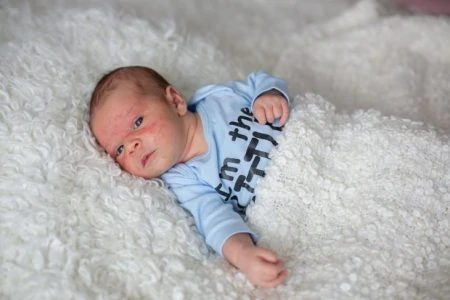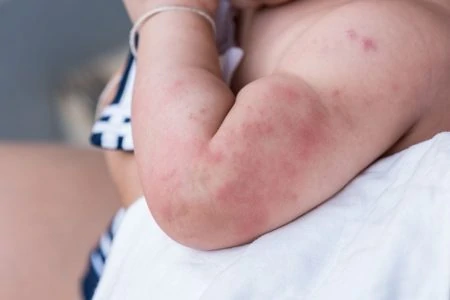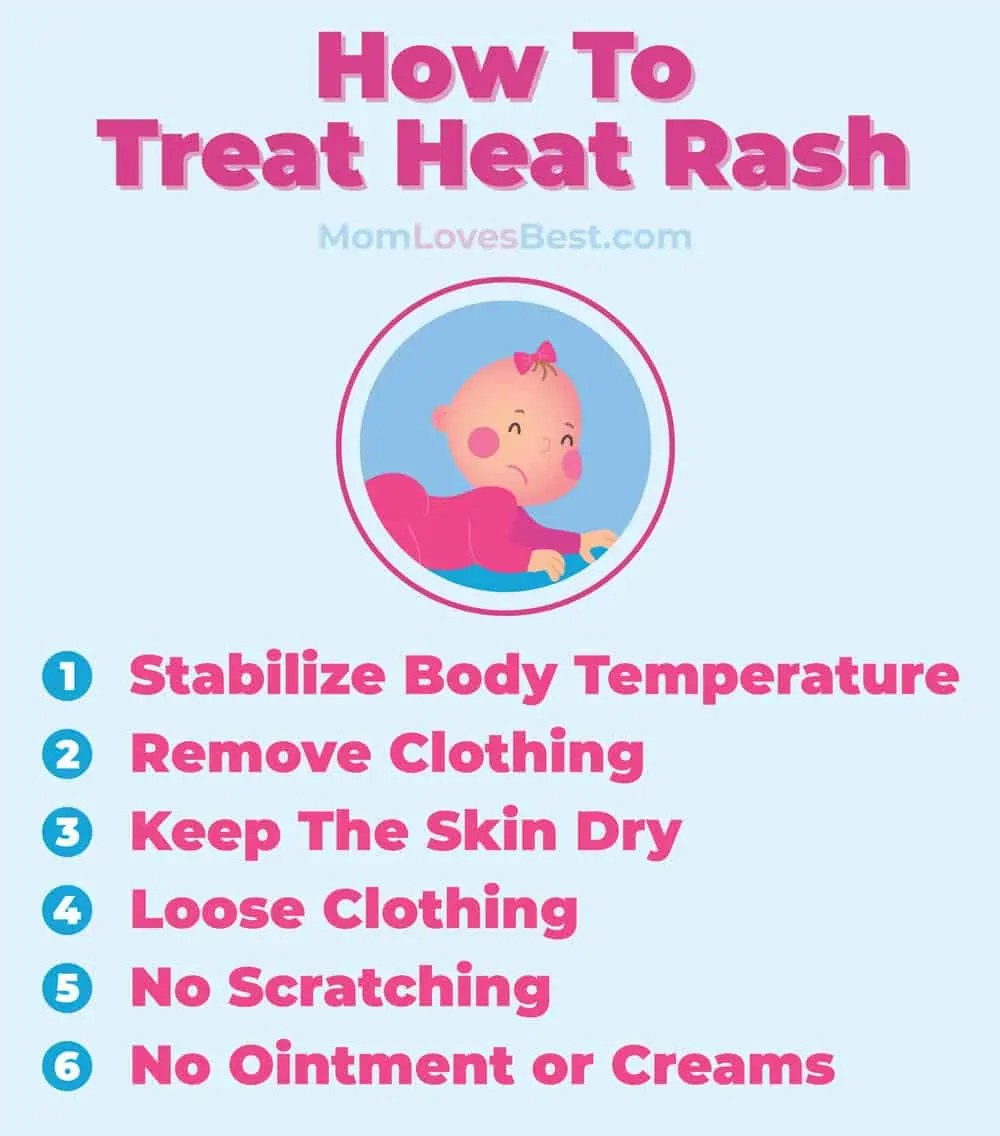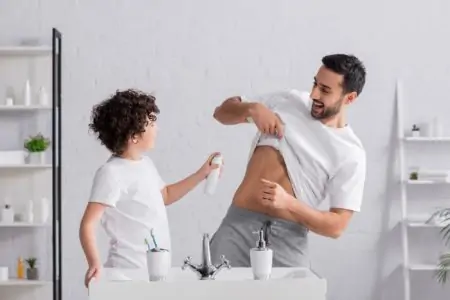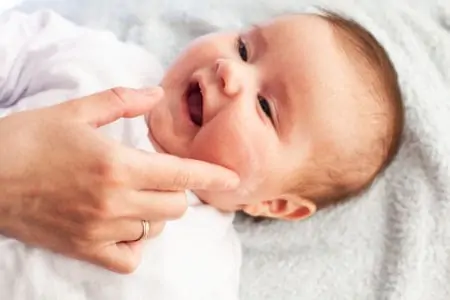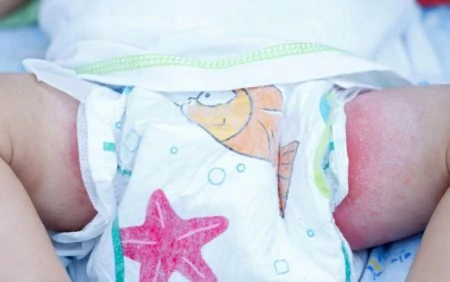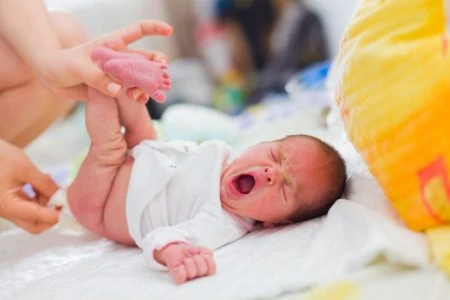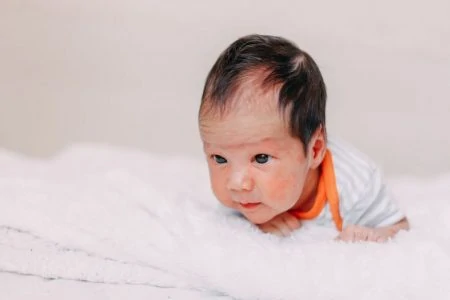Finding a red, bumpy rash on your baby’s soft skin can send any parent into a panic. Is it an allergy? Is it a bug bite? Or is it just the heat?
Babies have sensitive skin that is still developing, making rashes a common part of infancy. While seeing those angry red bumps is stressful, heat rash is usually harmless and easily treatable at home.
We’ll help you identify exactly what those bumps are, why they happen, and how to soothe your little one’s skin quickly. Here is everything you need to know about spotting, treating, and preventing baby heat rash.
Key Takeaways
- What it is: Heat rash (Miliaria) happens when blocked sweat ducts trap perspiration under the skin, causing red bumps or blisters.
- Common causes: Hot weather, high humidity, overdressing, or heavy creams that clog pores are the main culprits.
- Treatment: Cool the baby down immediately, let the skin air dry, and switch to loose, breathable cotton clothing.
- When to see a doctor: Seek medical advice if blisters contain pus, the rash lasts more than a few days, or your baby has a fever.
What Is Heat Rash?
Heat rash, technically known as miliaria, is often called prickly heat or summer rash. It appears when sweat gets trapped under the skin because of blocked pores.
While anyone can get it, newborns and infants are most susceptible because their sweat ducts aren’t fully developed yet. The rash typically looks like tiny pink or red bumps, similar to small blisters. On darker skin tones, the bumps may look purple, gray, or simply raised without extreme redness.
You will usually find these patches in areas where air circulation is poor, such as neck folds, armpits, the groin, or under tight clothing straps (1).
Signs and Symptoms
How do you know it’s heat rash and not something else? Look for these signs:
- Cluster of bumps: Tiny red bumps or clear fluid-filled blisters.
- Location: Concentrated in skin folds (neck, elbows, knees) or diaper areas.
- Discomfort: The baby seems cranky, itchy, or acts like the skin is prickling.
- Overheating signs: Damp hair, flushed cheeks, or rapid breathing.
Causes and Triggers
Heat rash happens for one simple reason: sweat cannot escape.
When your baby sweats to cool down, the perspiration travels up the sweat duct to the skin’s surface. If those ducts are blocked, common in babies with immature pores, the sweat gets trapped beneath the skin, causing inflammation.
Common triggers include:
- Hot, humid weather: Tropical climates or summer heatwaves are prime times for rashes.
- Overdressing: Wrapping a baby in too many layers, even in winter, can cause overheating.
- Heavy lotions: Thick creams and petroleum jelly can block pores, trapping sweat.
- Fever: If your baby is fighting a bug, the resulting fever and sweating can trigger a rash.
Keep In Mind
Is Heat Rash Dangerous?
On its own, heat rash is not dangerous. It is a sign that your baby is too warm, which is the real concern (2).
If a baby stays overheated for too long, they risk heat exhaustion or heat stroke, which are serious medical emergencies.
Additionally, overheating is a known risk factor for Sudden Infant Death Syndrome (SIDS). The rash is your warning signal. If you see it, take immediate steps to cool your baby down (3).
When to Call the Doctor
Most heat rashes resolve with simple home care. However, bacteria can sometimes invade the raw skin, leading to an infection.
Contact your pediatrician if you notice:
- Pus draining from the blisters.
- Swollen lymph nodes in the neck or groin.
- Red streaks extending from the rash area.
- A fever over 100.4 degrees Fahrenheit.
- The rash fails to improve after 3 days.
- The baby seems lethargic or refuses to eat.
How to Treat Heat Rash
The goal of treatment is to cool the skin and reduce friction. Avoid heavy ointments, as these can block pores further.
- Cool Down Immediately: Move your baby into an air-conditioned room or a shady spot. If you are outside, get indoors.
- Remove Layers: Take off clothing to let the skin breathe. If the diaper area is affected, allow some diaper-free time.
- Luke-warm Bath: Give your baby a lukewarm (not cold) bath to wash away sweat and oil. You can add a little colloidal oatmeal powder to the water to soothe itching.
- Air Dry: Skip the towel rub. Let your baby’s skin air dry to avoid irritating the sensitive bumps.
- Dress Loosely: Once dry, dress them in lightweight, loose-fitting cotton clothing. Avoid synthetic fabrics like polyester that trap heat.
- Trim Nails: Itchy skin leads to scratching, which leads to infection. Keep those fingernails short to prevent open wounds.
Prevention Tips
Preventing heat rash is all about temperature management and airflow (4).
- Check the neck: Hands and feet are often cool to the touch. To check if your baby is hot, feel their chest or the back of their neck. If it’s damp or hot, they are overdressed.
- Dress for the weather: A general rule of thumb is to dress your baby in the same number of layers you are wearing comfortably.
- Ventilate the car seat: Car seats are notorious heat traps. Use a sun shade on the window and cool the car down before buckling your baby in. Never leave a baby in a parked car.
- Hydrate: Keep your baby hydrated with breast milk or formula. If they are older than six months, small sips of water can help regulate body temperature.
- Create a breeze: Use a fan in the nursery to circulate air, but do not point it directly at the baby. This keeps the ambient air fresh and cool.
- Avoid heavy lotions: In hot weather, skip thick moisturizers on areas prone to heat rash. Let the pores breathe.
Should You See a Doctor?
You generally do not need a doctor for a simple heat rash. It usually fades within a few days of cooling off.
However, if you are unsure what the rash is, or if your baby seems ill, trust your gut and make the call. It is always better to rule out other conditions like viral rashes or eczema.
Heat Rash FAQs
The Bottom Line
Babies are still adjusting to the world, and their skin is extra sensitive to temperature changes. A little too much heat or humidity can quickly lead to those annoying red bumps.
The good news is that heat rash is a warning sign, not a disease. It tells you to change the environment. Focus on loose clothing, shade, and hydration.
If you suspect your baby is overheating, act fast to cool them down. A lukewarm sponge bath and some air conditioning usually work wonders. Trust your instincts, keep your little one cool, and those bumps should fade away in no time.
